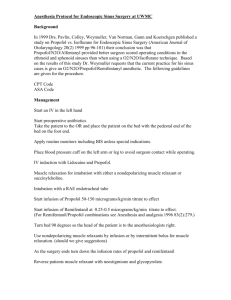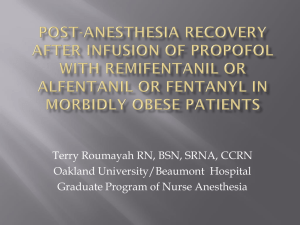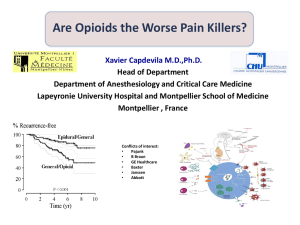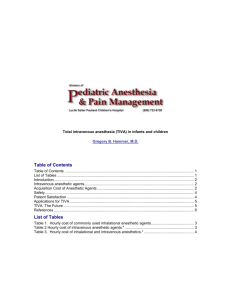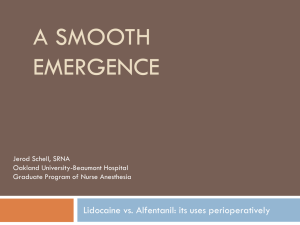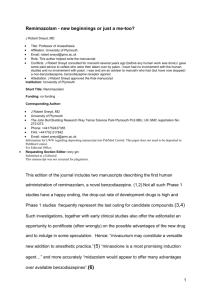Remifentanil 1995
advertisement
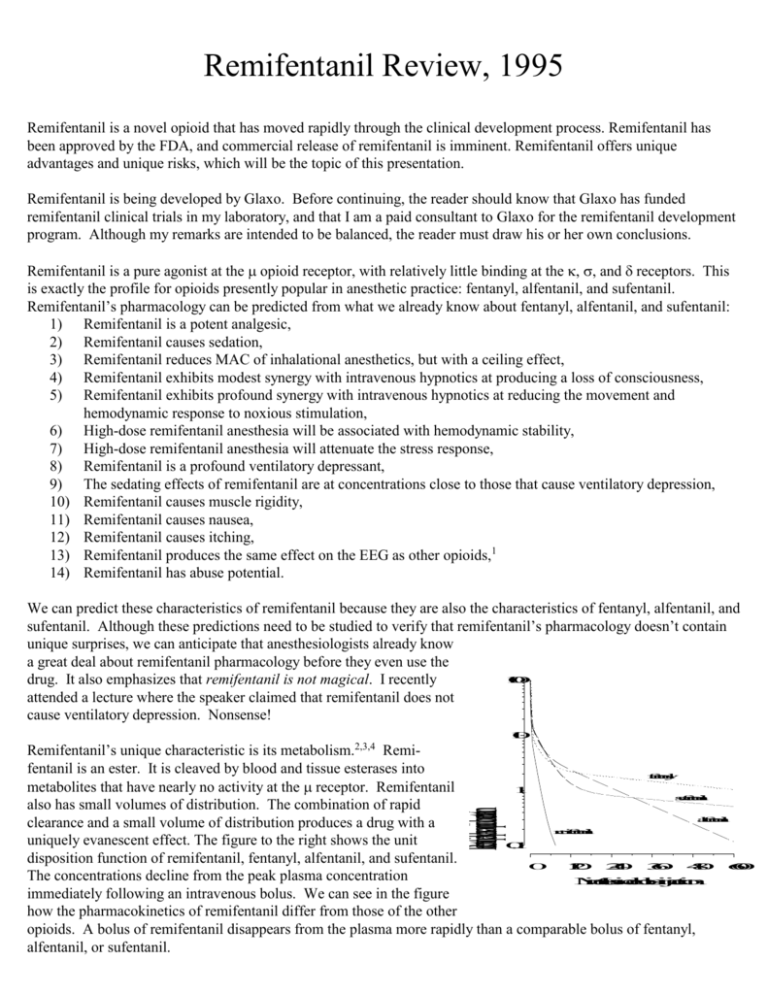
Remifentanil Review, 1995 Remifentanil is a novel opioid that has moved rapidly through the clinical development process. Remifentanil has been approved by the FDA, and commercial release of remifentanil is imminent. Remifentanil offers unique advantages and unique risks, which will be the topic of this presentation. Remifentanil is being developed by Glaxo. Before continuing, the reader should know that Glaxo has funded remifentanil clinical trials in my laboratory, and that I am a paid consultant to Glaxo for the remifentanil development program. Although my remarks are intended to be balanced, the reader must draw his or her own conclusions. Remifentanil is a pure agonist at the opioid receptor, with relatively little binding at the , , and receptors. This is exactly the profile for opioids presently popular in anesthetic practice: fentanyl, alfentanil, and sufentanil. Remifentanil’s pharmacology can be predicted from what we already know about fentanyl, alfentanil, and sufentanil: 1) Remifentanil is a potent analgesic, 2) Remifentanil causes sedation, 3) Remifentanil reduces MAC of inhalational anesthetics, but with a ceiling effect, 4) Remifentanil exhibits modest synergy with intravenous hypnotics at producing a loss of consciousness, 5) Remifentanil exhibits profound synergy with intravenous hypnotics at reducing the movement and hemodynamic response to noxious stimulation, 6) High-dose remifentanil anesthesia will be associated with hemodynamic stability, 7) High-dose remifentanil anesthesia will attenuate the stress response, 8) Remifentanil is a profound ventilatory depressant, 9) The sedating effects of remifentanil are at concentrations close to those that cause ventilatory depression, 10) Remifentanil causes muscle rigidity, 11) Remifentanil causes nausea, 12) Remifentanil causes itching, 13) Remifentanil produces the same effect on the EEG as other opioids,1 14) Remifentanil has abuse potential. We can predict these characteristics of remifentanil because they are also the characteristics of fentanyl, alfentanil, and sufentanil. Although these predictions need to be studied to verify that remifentanil’s pharmacology doesn’t contain unique surprises, we can anticipate that anesthesiologists already know a great deal about remifentanil pharmacology before they even use the 1 0 0 drug. It also emphasizes that remifentanil is not magical. I recently attended a lecture where the speaker claimed that remifentanil does not cause ventilatory depression. Nonsense! 1 0 Percntofpeakplasmopidconetraion Remifentanil’s unique characteristic is its metabolism.2,3,4 Remifentanil is an ester. It is cleaved by blood and tissue esterases into f e n t a n y l metabolites that have nearly no activity at the receptor. Remifentanil 1 s u f e n t a n i l also has small volumes of distribution. The combination of rapid a l f e n t a n i l clearance and a small volume of distribution produces a drug with a r e m i f e n t a n i l uniquely evanescent effect. The figure to the right shows the unit 0 . 1 disposition function of remifentanil, fentanyl, alfentanil, and sufentanil. 0 1 2 0 2 4 0 3 6 0 4 8 0 6 0 0 The concentrations decline from the peak plasma concentration M i n u t e s s i n c e b o l u s i n j e c t i o n immediately following an intravenous bolus. We can see in the figure how the pharmacokinetics of remifentanil differ from those of the other opioids. A bolus of remifentanil disappears from the plasma more rapidly than a comparable bolus of fentanyl, alfentanil, or sufentanil. The pharmacokinetics of remifentanil suggest that within 10 minutes of starting an infusion remifentanil will nearly reach steady state. The figure to the right shows the effect-site concentrations of fentanyl, alfentanil, sufentanil, and remifentanil during a zero-order (i.e., constant rate) infusion. The concentrations are expressed as a percent of the eventual steady-state concentration. Within 4 minutes of starting an infusion rate the remifentanil concentration in the effect site is already within 50% of the steady-state concentration, while the fentanyl, alfentanil, and sufentanil concentrations are below 15% of the steady-state concentration. By 10-15 minutes the effect-site concentrations of remifentanil are 80% of the steady-state concentration, while the concentrations of the other opioids are still less than 30% of the steady-state concentration. Thus, the very rapid clearance, combined with the rapid blood-brain equilibration, result in rapid changes in drug effect following adjustments in infusion rate. sufentanil 80 fentanyl 60 40 alfentanil 20 remifentanil 0 Percent of0peak effect 2 site opioid 4 concentration 6 8 Minutes since bolus injection 6 0 10 2 0 % d e c r e a s e 4 0 f e n t a n y l 2 0 a l f e n t a n i l s u f e n t a n i l 0 r e m i f e n t a n i l 1 2 0 5 0 % d e c r e a s e f e n t a n y l 9 0 a l f e n t a n i l 6 0 s u f e n t a n i l 3 0 Minutesrequiredforagivenpercentdecreaseinefectsiteconcentration Remifentanil’s rapid metabolism and small volume of distribution means that remifentanil will accumulate less than other opioids. This has a profound influence on the relationship between infusion duration and the time required for the plasma and effect-site concentrations to decrease by any given percent when the infusion is terminated. Using the computer simulations5 we can examine the time required for decreases of 20, 50, and 80% in the effect-site opioid concentration for remifentanil, fentanyl, alfentanil, and sufentanil. The simulations assume that a pseudo-steady state concentration has been maintained in the effect-site. The time for 50% recovery is similar to the “contextsensitive half-time” proposed by Hughes and colleagues.6 The pharmacokinetic/pharmacodynamic model predicts that the effect-site remifentanil concentration will decrease by 80% within 10 minutes of turning off a continuous, pseudo-steady state infusion, regardless of the infusion duration. Remifentanil is described by a three-compartment pharmacokinetic model, which implies some tissue accumulation. However, since the time for an 80% decrease in effect-site concentration appears independent of concentration, this implies that the tissue accumulation of remifentanil is clinically insignificant. 100 r e m i f e n t a n i l 0 3 0 0 8 0 % d e c r e a s e f e n t a n y l 2 4 0 a l f e n t a n i l 1 8 0 1 2 0 s u f e n t a n i l 6 0 r e m i f e n t a n i l 0 0 1 2 0 2 4 0 3 6 0 4 8 0 6 0 0 M i n u t e s s i n c e b e g i n n i n g o fi n f u s i o n 1 0 0 r e m i f e n t a n i l 8 0 6 0 a l f e n t a n i l 4 0 efctsieopidPcoenrcenttroafisotneady-stae Remifentanil has an onset that resembles the onset of alfentanil. For the past 15 years we have used the EEG as a measure of opioid drug effect to measure the rate of equilibration between the plasma and the site of opioid drug effect within the brain. Dr. Talmage Egan recently characterized this equilibration delay for remifentanil. The results of his work, shown to the right, suggest that remifentanil will have an alfentanil-like onset. The peak effect-site concentration following a bolus of remifentanil will be observed within 1.5 minutes following a bolus injection. However, the effect will be more transient than for a similar bolus of alfentanil. Six minutes following a bolus injection, the alfentanil concentration in the effect site will be approximately 40% of the peak concentration, while the remifentanil concentration will be about 20% of the peak concentration. s u f e n t a n i l 2 0 f e n t a n y l 0 0 1 0 2 0 3 0 4 0 5 0 6 0 M i n u t e s s i n c e b e g i n n i n g o f c o n t i n u o u s i n f u s i o n Since the variability in steady state concentrations reflect the variability in clearance, the variability in remifentanil concentration during clinical care will almost totally reflect variability in remifentanil clearance. Esterase metabolism appears to be a very well-preserved metabolic system with little variability between individuals. In our studies, remifentanil concentrations have shown about 30% less residual variability than we have observed with other opioids, and about 50% less variability than we have observed with hypnotics (thiopental, propofol). Additionally, it is likely that remifentanil’s pharmacokinetics will be unchanged by renal or hepatic failure, or by pseudocholinesterase deficiency, as esterase metabolism is usually preserved in these states. As Carl Rosow pointed out in his elegant editorial, remifentanil may finally give us a truly predictable opioid.7 To summarize the pharmacokinetic and pharmacodynamic differences between remifentanil and the presently available opioids: 1) the drug is cleared extremely rapidly from the plasma, 2) the plasma-effect site equilibration is very rapid, 3) the rate of decline in plasma and effect-site remifentanil concentration will be nearly independent of the infusion duration, 4) a remifentanil infusion rate will rapidly approach steady-state in the plasma and effect site, and 5) the relationship between infusion rate and opioid concentration will be less variable for remifentanil than for other available opioids. What are the implications this unique pharmacokinetic and pharmacodynamic profile for the clinician? We can again use our knowledge of opioids in the practice of anesthesia to predict some clinical utility, and some risks, with remifentanil. First, the potentially useful implications of remifentanil’s unique pharmacokinetics and pharmacodynamics: 1) In cases where profound opioid effect is desired transiently (e.g., analgesia prior to placement of a retrobulbar block), remifentanil may produce profound analgesia for a few minutes. This follows directly from the effect-site remifentanil profile shown above. 2) High-dose opioid anesthetic techniques can be used with little risk of ventilatory depression in the post-operative period, 3) Anesthesia maintained with high-dose remifentanil will be associated with rapid recovery, 4) Remifentanil can be used as the analgesic component of a sedation case with the ability to rapidly recover from an overdose by simply turning the infusion off, 5) Changes in remifentanil drug effect rapidly follow changes in the remifentanil infusion rate. This may make titration of remifentanil more precise than with the presently available opioids, 6) Remifentanil’s rapid metabolism may make it possible to use as an opioid with “virtual pharmacokinetics” (described below). For example, remifentanil might be made to appear as an opioid with an alfentanil-like onset, but a morphine-like offset. Such a drug would have utility in a smart PCA device. 7) The relationship between remifentanil infusion rate and concentration will be consistent from patient to patient, and will be independent of disease state. There are also risks implied by remifentanil’s unique metabolism: 1) The rapid onset of remifentanil may be associated with life-threatening rigidity if large doses are administered by bolus or rapid infusion. 2) The analgesic effects of remifentanil will be evanescent. Patients who are likely to have a post-operative analgesic requirement will require either a remifentanil infusion in the post-operative period, or substitution of another opioid. This transition from remifentanil-based analgesia to non-remifentanil-based analgesia may be tricky. 3) The rapid onset and offset of remifentanil drug effect may make post-operative titration difficult, with the clinician oscillating between rigidity and apnea at one extreme, and untreated pain at the other. 4) If a remifentanil infusion is interrupted during surgery, very little time exists for the physician to discover the error before the patient awakens in pain. 5) Remifentanil may be dangerous in the hands of physicians not trained in the practice of anesthesia. If it is given by physicians who are not prepared to manage the airway, the patient may be injured from the opioid-induced rigidity and ventilatory depression. So, how might remifentanil change how we practice anesthesia? In 4 0 0 A 3 0 0 the July issue of Anesthesiology, Vuyk and colleagues develop a 2 0 0 model of the interaction between propofol and alfentanil during 1 0 0 0 intubation, maintenance, and emergence of anesthesia.8 In an 6 B accompanying editorial Donald Stanski and I used Vuyk’s interaction 4 model to define the infusion rates and concentrations of propofol and 2 alfentanil that would be used to maintain patients at an IC50 for 0 4 0 0 C hemodynamic responsiveness during anesthesia (a “light” anesthetic 3 0 0 2 0 0 by definition) and would provide for the most rapid possible 1 0 0 awakening at the conclusion of anesthesia.9 The figure to the right 0 2 0 shows the results of our modeling exercise. The maintenance D 1 5 infusion rates for propofol and alfentanil appear in Panel A. 1 0 5 Following intubation the propofol infusion starts at 180 mg/kg/min 0 for 10 min, decreases to 140 mg/kg/min from 10-30 min, and then 1 0 0 E 7 5 decreases to approximately 100 mg/kg/min for the next 9.5 hours. 5 0 The alfentanil infusion rate for the first hour is approximately 350 2 5 0 ng/kg/min, and is then decreased to about 250 ng/kg/min for the remainder of the anesthetic. Panels B and C show the propofol and 0 1 2 0 2 4 0 3 6 0 4 8 0 6 0 0 T i m e ( M i n u t e s ) alfentanil concentrations during maintenance (solid lines) and upon emergence following termination of the infusion (dotted lines) based upon the dosing guidelines from panel A. The interaction models favor a relatively high effect-site alfentanil concentration (344 ng/ml) and a modest propofol concentration (1.44 mg/ml) for the noxious stimulation of intubation. Following intubation, the propofol level is raised to 3-3.5 mg/ml, while the alfentanil concentration is immediately lowered to 85-100 ng/ml. The dashed lines in panels B and C show the predicted concentration when the patients awaken as a function of infusion duration. Panel D shows the number of minutes from the end of the infusion to awakening, as a function of the duration of drug administration. The simulation shows that when carefully constructed dosing guidelines are used, the typical patient will awaken from a total intravenous anesthetic with propofol and alfentanil within 20 minutes of terminating the infusions. Panel E of shows the percent decrease in propofol and alfentanil concentration required for emergence at the conclusion of the “optimal” anesthetic developed from the interaction models. The propofol concentration at the effect site must decrease by 50%, while the alfentanil concentration decreases by 25-35%. Propofl( g/ml) InfusionRates A l f e n t a n i l( n g / k g / m i n ) P r o p o f o l( g / k g / m i n ) M a i n t e n a n c e c o n c e n t r a t i o n C o n c e n t r a t i o n o n e m e r g e n c e Alfentanil(ng/ml) M a i n t e n a n c e c o n c e n t r a t i o n C o n c e n t r a t i o n o n e m e r g e n c e RecoveryTime M i n u t e sf r o m e n d i n g t h e i n f u s i o n st o a w a k e n i n g RecoveryPercent P r o p o f o lp e r c e n td e c r e m e n tf o re m e r g e n c e 4 0 0 A R e m i f e n t a n i l( n g / k g / m i n ) 3 0 0 Propofl( g/ml) InfusionRates 2 0 0 1 0 0 P r o p o f o l( g / k g / m i n ) 0 6 4 M a i n t e n a n c e c o n c e n t r a t i o n C o n c e n t r a t i o n o n e m e r g e n c e B M a i n t e n a n c e c o n c e n t r a t i o n C o n c e n t r a t i o n o n e m e r g e n c e C 2 0 2 0 Remifen(tnagn/imll) 1 5 1 0 5 0 2 0 D 1 5 RecoveryTime 1 0 M i n u t e sf r o m e n d i n g t h e i n f u s i o n st o a w a k e n i n g 5 0 1 0 0 R e m i f e n t a n i lp e r c e n td e c r e m e n tf o re m e r g e n c e 7 5 E 5 0 RecoveryPercent How will remifentanil change total intravenous anesthesia? Because remifentanil and alfentanil are both pure agonists, I will assume that the interaction between remifentanil and propofol is the same as that demonstrated by Vuyk and colleagues between alfentanil and propofol, adjusted for the different potency and pharmacokinetics of remifentanil. Repeating the modeling exercise produces the results shown to the right. When combined with remifentanil, propofol becomes the drug whose pharmacokinetics limit the rate of recovery. The balance shifts to a lower dose of propofol and a higher opioid concentration. Panel B shows a lower propofol concentration during maintenance than in the prior panel B above. Panel B also shows how little the propofol must decrease for patients to awaken. Because of remifentanil’s rapid metabolism and blood-brain equilibration, the remifentanil concentration during anesthesia is well in excess of the concentration required for emergence (panel D). The net effect of this changed balance is that recovery will typically be expected within 5 minutes (panel D), during which time the remifentanil concentration decreases by 60% while the propofol concentration decreases by only 25% (panel E). The modeling exercise shows that remifentanil used for total A l f e n t a n i lp e r c e n td e c r e m e n tf o re m e r g e n c e 2 5 P r o p o f o lp e r c e n td e c r e m e n tf o re m e r g e n c e 0 0 1 2 0 2 4 0 3 6 0 T i m e ( M i n u t e s ) 4 8 0 6 0 0 intravenous anesthesia may produce a shift in the anesthetic balance towards relatively higher opioid concentrations and lower hypnotic concentrations. The advantage of such a shift is a more rapid emergence on conclusion of the anesthetic. Of course, there may be disadvantages as well, and thus the predictions of this modeling exercise must be rigorously tested prospectively. How will remifentanil change titration? One possibility is that titration may become totally unnecessary in the anesthetized, ventilated patient because of the rapid clearance and plasma-effect site equilibration of remifentanil. We may elect to give all of our patients an ED99.99, knowing that a gross overdose will result in little additional time for emergence at the conclusion of the anesthetic. For patients who are breathing spontaneously (e.g., patients requiring sedation and analgesia), titration will remain an important concern. Remifentanil may offer benefits in ease of titration because of the close link between infusion rate and effect site concentration. This link is sometimes referred to as “real-time pharmacodynamics.” 5 1 5 4 1 0 RemifntalIfusionRate( g/min) 3 2 5 SiteConctraion(Rge/mif)ntalEfect The figure to the right is an example of the linkage between infusion rate and effect-site concentration for remifentanil. In this simulation the infusion rate, shown as the dotted line, is stepped up and down over 60 minutes. Each step is followed by a rapid response in the effect site concentration. Within 10 minutes of the step change, the effect site concentration has started to level off at the new concentration. The rapid response to an increase in infusion rate is a consequence of remifentanil’s rapid plasma-effect-site equilibration. However, it is the rapid response to the decrease in infusion rate, as shown here, that really sets the remifentanil apart from the other opioids. This rapid response to a decrease in infusion rate is a function of both the very rapid ester hydrolysis and the rapid blood-brain equilibration. 1 0 0 0 1 53 04 56 07 59 0 M i n u t e s S i n c e B e g i n n i n g I n f u s i o n Remifentanil will also open up interesting new therapeutic applications. Let us briefly consider remifentanil PCA. It seems, a priori, absurd to use a very short acting drug for a long-term analgesic requirement, such as PCA. Additionally, PCA with remifentanil would require a continuous infusion, and continuous infusions of opioids have been implicated in fatal opioid overdoses with PCA. However, one could use a PCA device to administer an infusion of remifentanil that would decrease over time. For example, in response to a patient request for analgesia, the PCA could infuse remifentanil in a manner that provided an onset like alfentanil, but an offset like morphine. Thus, the patient would rapidly receive an analgesic effect, permitting perhaps a shorter lockout on the device. However, the opioid levels would decrease slowly over time just as though morphine had been given. This would provide for the inherent safety of a PCA device. 2 . 0 O n s e t l i k e a l f e n t a n i l 1 . 5 O f f s e t l i k e m o r p h i n e 1 . 0 RemifnCtoalEfrectoSni(g/ml) The figure to the right shows the effect site concentrations over time for “bolus” of a “virtual opioid” with an alfentanil like onset and a morphine like offset. The rapid pharmacokinetics of remifentanil would permit an intelligent device to infuse remifentanil to resemble a bolus of such a drug. Additionally, the pharmacokinetics of the virtual drug could be tailored in real time to produce a request for additional analgesia at intervals selected for maximum therapeutic benefit. For example, the offset could be adjusted during daytime to trigger a request every 45 minutes, but at night time the offset could initially be rapid (to provide safety once the patient has fallen asleep), but then slowed, to provide for patient awakening and requesting drug at 120 minute intervals. 0 . 5 0 . 0 0 3 0 6 0 M i n u t e s S i n c e B o l u s 9 0 To conclude, remifentanil is a novel opioid that is likely to be the next important intravenous anesthetic introduced into clinical practice. Remifentanil’s pharmacology is that of a pure agonist, with all the benefits and risks associated with that category of drugs. The blood-brain equilibration of remifentanil is similar to that of alfentanil. However, the pharmacokinetics of remifentanil are characterized by small volumes, rapid clearances, and low variability compared to other intravenous anesthetic drugs. The result is that the remifentanil drug effect will rapidly change in response to changes in infusion rate, and will be evanescent when the infusion is discontinued. Advantages of this unique pharmacokinetic profile will probably include precise titration of opioid drug effect, the ability to maintain high opioid concentrations during surgery to attenuate the stress response, rapid recovery from remifentanil anesthesia, and the potential for creating more intelligent infusion pumps and PCA devices using remifentanil. Disadvantages may include pain on arrival in the recovery room while anesthesiologists learn how use remifentanil, the need for smooth transition to other opioids in the post-operative period, the possibility of almost immediate intraoperative pain should an infusion become disconnected during surgery, and therapeutic disasters when administered by physicians not trained in the practice of anesthesia. Many of the conclusions about remifentanil that I have presented in this review are based on knowledge of opioid pharmacology and remifentanil pharmacokinetics. These conclusions are now being tested in clinical trials, and will be either supported or refuted before remifentanil is introduced into clinical practice. Stay tuned! References: 1 Hoffman WE, Cunningham F, James MK, Baughman VL, Albrecht RF. Effects of remifentanil, a new short-acting opioid, on cerebral blood flow, brain electrical activity, and intracranial pressure in dogs anesthetized with isoflurane and nitrous oxide. Anesthesiology 79:107-113, 1993 2 Glass PS, Hardman D, Kamiyama Y, Quill TJ, Marton G, Donn KH, Grosse CM, Hermann D. Preliminary pharmacokinetics and pharmacodynamics of an ultra-short-acting opioid: remifentanil (GI87084B). Anesth Analg 77:1031-1040, 1993 3 Egan TD, Lemmens HJ, Fiset P, Hermann DJ, Muir KT, Stanski DR, Shafer SL. The pharmacokinetics of the new short-acting opioid remifentanil (GI87084B) in healthy adult male volunteers. Anesthesiology 79:881-892, 1993. 4 Westmoreland CL, Hoke JF, Sebel PS, Hug CC Jr; Muir KT. Pharmacokinetics of remifentanil (GI87084B) and its major metabolite (GI90291) in patients undergoing elective inpatient surgery. Anesthesiology 79:893-903, 1993 5 Shafer SL, Varvel JR. Pharmacokinetics, pharmacodynamics, and rational opioid selection. Anesthesiology 74:5363, 1991 6 Hughes MA, Glass PS, Jacobs JR. Context-sensitive half-time in multicompartment pharmacokinetic models for intravenous anesthetic drugs. Anesthesiology 76:334-341,1992 7 Rosow C. Remifentanil: a unique opioid analgesic. Anesthesiology 79:875-876, 1993. 8 Vuyk J, Lim T, Engbers FHM, Burm AGL, Vletter AA, Bovill JG. The pharmacodynamic interaction of propofol and alfentanil during lower abdominal surgery in women. Anesthesiology 83 (in press: July 1995) 9 Stanski DR, Shafer SL. Quantifying anesthetic drug interaction: implications for drug dosing. Anesthesiology 83 (in press, July 1995)
